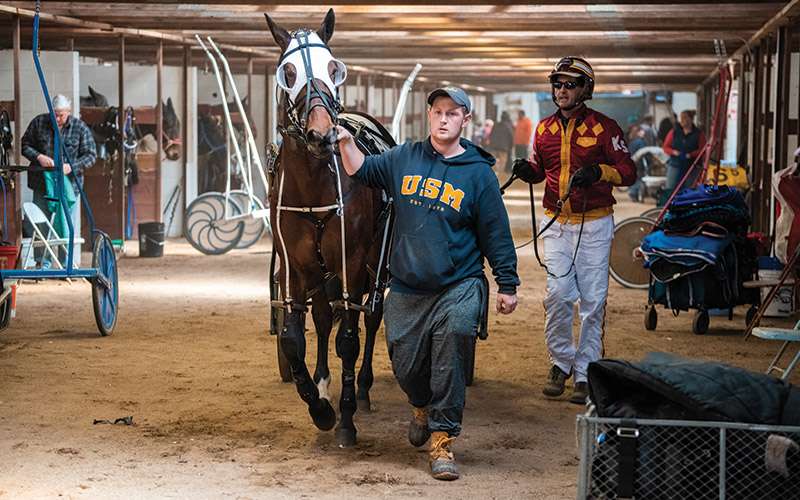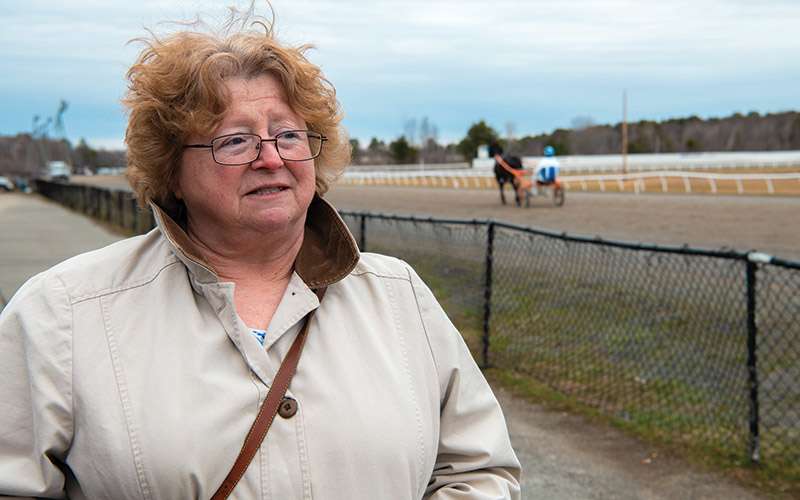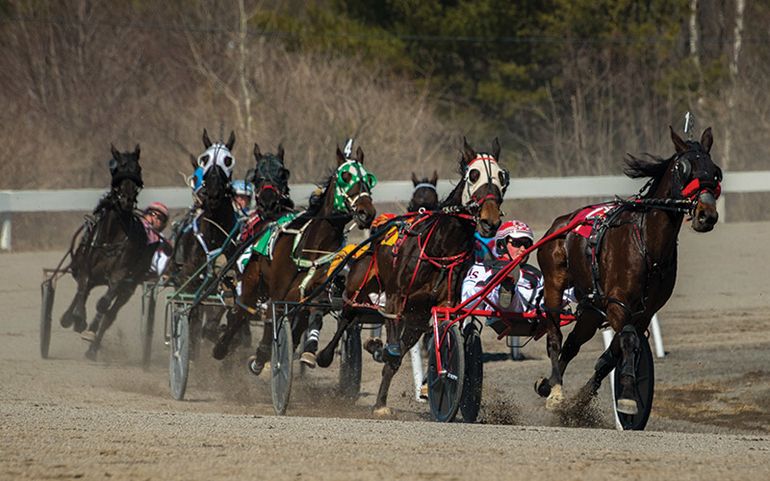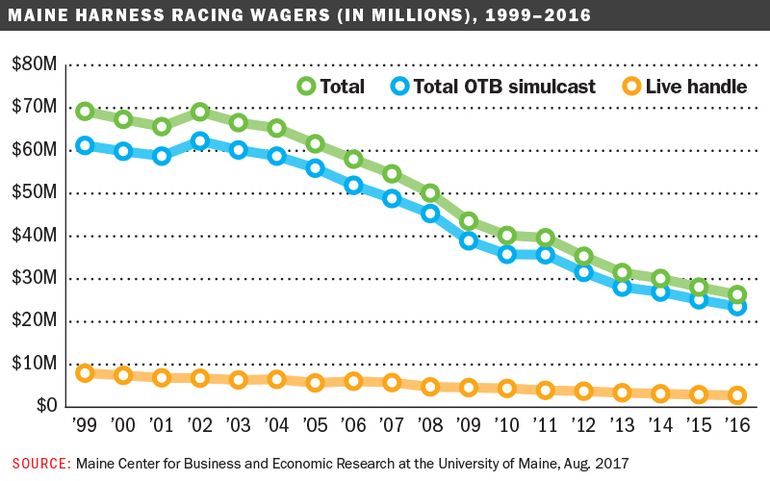
Maine's harness racing industry pursues new ideas to get back on track as entertainment option
Between Saturday harness races at Scarborough Downs, McGwire Sowers stops at the paddock to change horses and sulkies, his face aglow with excitement.
The 18-year-old has been coming to the track since age eight and has become one of its winningest drivers in his debut as a professional.

“We're giving the older guys a run for the money,” he says.

Out of 10 races he drove in that day, he finished in the money six times, including wins with Falcon's Luke in the first and O'Wow in the second.
He's hoping to stay in the sport a long time, saying, “I want this to be my job.”
Whether he'll be able to do that is questionable, given harness racing's shaky future. The industry has been in decline for years because of growing competition from other forms of entertainment, and a struggle to attract younger fans. That's forcing industry players and regulators to find new ways to get harness racing back on track.
“Job No. 1 is to stop the bleeding,” says Henry Jennings, executive director of the Maine Harness Racing Commission. Concretely, the agency is looking into introducing three new races in 2018 including a European Series involving at least 10 horses. It's also looking into the possibility of simulcasting Maine races in Europe, where harness racing is more popular. On the marketing front, it aims to better coordinate industry-wide marketing efforts and focus on social media. It may also run TV ads during the upcoming Kentucky Derby.
“We're trying to see where we can get the most bang for our buck,” he says.
Heyday and modern day
Unlike thoroughbred and quarterhorse racing, where jockeys ride on saddled equines, harness racing entails racing a two-wheeled cart known as a sulky pulled by a Standardbred trotting or pacing for a mile.
The sport has a storied tradition in Maine, which had at least 90 parks registered with the National Trotting Association between 1890-1930 according to Stephen Thompson, the Hallowell-based founder of the Lost Trotting Parks Heritage Center online museum (lostrottingparks.com). He also recalls Maine's strong breeding heritage that has long since disappeared.
Through photos, maps and historical documents, Thompson aims to promote harness racing to a wider audience by generating excitement about horses. “You're not going to bring someone in if they're just looking for somewhere to gamble,” he says.
While that may be true, tracks make their money from a cut of the handle, or wagering, which has been going down steadily for years.
In Maine, betting on harness racing slid from about $70 million in 1999 to $26 million in 2016, according to The Maine Center for Business and Economic Research at the University of Southern Maine [see chart]. The newly published annual report from the Maine State Harness Racing Commission shows that trend continued in 2017, with $24.5 million wagered. Of that amount, $21.6 million was bet on races shown live on television from tracks out of state.
In terms of racing's wider impact, USM researchers found that activity associated with the industry supported $57.5 million in total economic output in 2016, which includes $20 million in what owners spent on animal care and training, and $16.5 million in tourism spending.
Today, Maine hosts harness races at commercial tracks in Scarborough and Bangor and at agricultural fairs.
Scarborough Downs, recently sold to local investors but still run by the Terry family, employs about 60 and had a 2016 operating budget of $2.8 million, according to the Harness Racing Commission's latest annual report. In Bangor, the Hollywood Casino & Raceway Bangor is operated by Penn National Gaming Inc. (NASDAQ: PENN) and owned by Gaming and Leisure Properties Inc., a real estate investment trust spun off of Penn Gaming. The Raceway had 2016 operating costs of $1.7 million but undertook nearly $94,000 in capital improvements including $59,850 to upgrade the recreational-vehicle lot, $15,425 for a water truck and $9,500 on upgrading racetrack surveillance.
Both tracks have trimmed their racing schedules. Bangor Raceway will hold races 46 days this year rather than 54, while Scarborough Downs, no longer obligated to have 101 racing days, has gone from three days to two days a week.
“We drove it down to make the competition better,” says Michael Hopkins, who manages live racing in Bangor. “It will give us more horses to enter the box here.” Its season runs from May 5 to November 9, holding afternoon races on Triple Crown days and otherwise in the evening. Scarborough's season runs from March 31 to Dec. 9, with a lighter schedule during the fairs.
Down but not out
Scarborough Downs, built in 1950 to host a one-month summer thoroughbred meet, has been overstretched for years.
“It was never built to do what we're asking it to do right now,” says Mike Sweeney, who handles marketing and publicity in addition to lobbying and serving as the track's announcer and handicapper. The 58-year-old has known the track since childhood and started working there in 1981 selling tickets, when there was racing six days a week from Memorial to Labor Day.
“The place was mobbed every single night, and there were probably about 300 employees working here at the time.” Like a number of other employees who've made a career at the track, he juggles multiple responsibilities.
Sweeney does it with aplomb, doing his handicapping shtick on camera before pressing the button to play the bugle that calls riders to the post, then dashing to the window to call the next race sporting binoculars and sunglasses.
A licensed harness driver himself, a few years ago he ducked out of the announcer's box to participate in an amateur race, called by one of the regular drivers. After winning the race, Sweeney dropped his horse off at the paddock and drove back to announce the next race. “It was fun,” he recalls.
Scarborough Downs marked a turning point in January when it was purchased by two sets of local brothers — William, Marc and Rocco “Roccy” Risbara III of Risbara Bros. and Peter and Richard Michaud, formerly of Michaud Distributors — for $6.7 million from the Terry family. They bought the track and the 480 acres on which it sits.
As the new owners focus on long-term plans to develop the property, they are happy to let the Terrys run racing operations for at least two more years.
“It's not a secret that the harness racing industry has been in decline, and also that Scarborough Downs has struggled because of it,” says Rocco Risbara on the group's behalf. “But that track is part of our town's history. It also is home to 60-plus jobs and we wanted to give the Terry family a chance to preserve all of that. We're all hopeful that without the cost burden to shoulder the property and taxes, the business will have more flexibility to become profitable once again.”
Denise Terry, the track's vice president of finance, says that while it took her family a long time to sell, she feels they made the right choice.
“It was a kind of win-win situation that we were able to sell it, and still be able to be here as a race track,” she says. “It was important for me and my mother to know that the jobs were still here for the people. I love the industry, and I also don't want to go out and find another job. I've dedicated my whole life to this.”
In hopes of bringing more people to the track and luring folks back, 2018 racing highlights include the return of the Mid-Summer Classic with a $25,000 purse and a Maine Sire Stakes Preview for two- and three-year-olds.
Sweeney, who has just a $30,000 annual marketing budget to work with, is also putting energy into social media, mainly Facebook and Instagram.
Rocknalltheway to victory
Back at the track on a blustery Saturday, regulars filling out betting slips in front of TV screens don't seem to mind the absence of slot machines the owners would love to have, while horse co-owner Cindy Pelletier is outside cheering on one of her “five babies.”
“This is my chance to be a soccer mom,” she says before seeing six-year-old gelding Rocknalltheway whiz by. “Good boy, Roc!” The horse, driven by Dan Deslandes, goes on to win the one-mile race in 1.59.2, matching the record set by Secretariat in the 1973 Kentucky Derby — though he had to travel ¼ mile further.















Comments